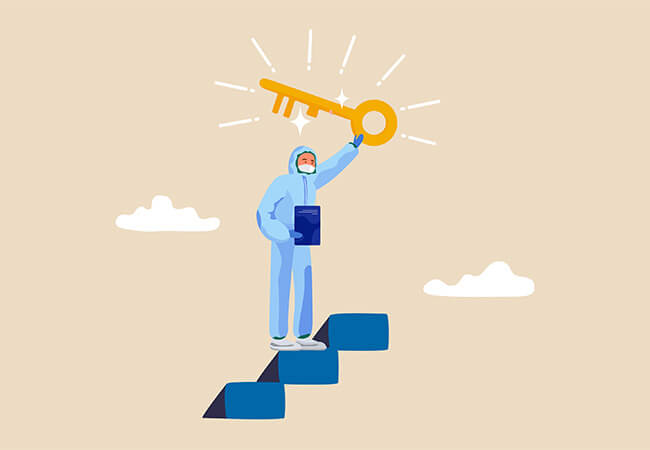Good Automated Manufacturing Practices (GAMP) has been defining IT validation since 1991. Since then, it has gone through 5 revisions, the most recent of which was in 2008. This version of the guidelines is called GAMP5. It is published by the International Society for Pharmaceutical Engineering (ISPE), specifically for pharmaceutical cleanrooms. GAMP is both a set of guidelines they publish and an ISPE committee.
GAMP5 outlines a system for computerized system validation through a lifecycle model that produces a traceable, repeatable process. While it is specifically designed for the pharmaceutical industry, it offers solid guidance for a wide range of industries when it comes to validating and implementing a Real Time Monitoring System (RTMS).
To better understand the premise of GAMP5, let’s take a look at the 5 key concepts: product and process understanding, life cycle approach within the QMS, scalable lifecycle activities, science based QRM, and leveraging supplier involvement.
Product And Process Understanding
The most intrinsic piece of GAMP5 is having a deep understanding of your product and process. One of the first steps in using the GAMP5 framework is creating a User Requirement Specification (URS) that drives the rest of the process.
This URS should be developed using a risk-based approach based on deep knowledge of your process. It will determine locations that need higher levels of testing and help you develop your Functional Specification (FS) as well as your hardware and software requirements. It will dictate what components you need in your RTMS, such as sensor accuracy, traceability, and applicable cleanroom and calibration standards.
This is one point where you already start to see supplier involvement. It can be a daunting task to develop a well-rounded URS. Where do you even start?
Here at LWS, we offer URS templates to give you a solid plan. You can then take the template and adapt it to your unique application, process, and industry.
Life Cycle Approach To The QMS
The next key concept to GAMP5 is the life cycle approach it takes to your Quality Management System (QMS).
Essentially this means that GAMP5 provides a comprehensive and organized approach to planning, designing, developing, verifying, implementing, and retiring the system. From start to finish, the framework is controlled and pragmatic. This does a few things.
First, this approach ensures system compliance. By integrating compliance into the initial design phases of the system, you vastly improve your ability to follow regulations.
Second, GAMP5’s unique life cycle design improves the system’s quality and effectiveness. It is a comprehensive take on the implementation of the system, meaning you start with stakeholder input, risk-based analysis, and scalability to make evidence-based decisions regarding the design of your system, allowing for maximum effectiveness.
Third, it can decrease costs. By using the aforementioned method and implementing all the needed information, you can identify issues early on in the life cycle process and correct them. It is much more cost-effective to correct and address issues early on rather than attempting to fix them when the system is already in place.
Scalable Life Cycle Activities
The life cycle approach allows for structured development, but it is not a universal solution in the way that it does not impose a “one size fits all” approach. The framework outlined in GAMP5 also emphasizes scalability in the computer systems used in the process.
The trick is, though, you have to incorporate scalability best practices into the life cycle approach. By developing around the ability to scale, you allow yourself room for future adjustments and agility.
Science Based QRM
In GAMP5, there is a direct correlation between your risk assessment and scalability relative to computer systems based on the overall life cycle. This means you will conduct a risk assessment and develop a Quality Risk Management (QRM) framework around a specific objective and scientific and technical evaluation of the system.
As GAMP5 is technically for the pharmaceutical industry, this evaluation should pay attention to the patient safety, product quality, and data integrity. In other industries, you should decide on applicable evaluation points.
Leveraging Supplier Involvement
The last key concept of GAMP5 is how you should leverage supplier involvement. We already mentioned that a vendor could be involved in the URS by helping you identify where to start and what to consider, but it does go farther than that. While you should be incredibly involved in developing your URS, QMS, and QRM, GAMP5 provides a framework that helps you identify where and how to leverage the knowledge and expertise of your vendors.
To demonstrate, GAMP5 uses the GAMP V model to implement a new RTMS through 5 phases. In the third phase, which involves the implementation and testing of the RTMS, your vendor is the primary participant. They are assembling your system with some suggested interaction from you.
By relying on your vendor, you can reduce redundant testing and documentation, expedite validation, improve efficiency, and ensure a high level of compliance.
But that requires working with a vendor who abides by GAMP5.
Here at LWS, we take GAMP5 very seriously. We develop our systems around compliance and aim to be your collaborative partner in clean air. We work hard to not only provide you with a top-of-the-line system that makes your life easier and gives you confidence in your cleanroom, but also education around your system and how to get the most out of it. We remain available aftermarket for help and provide online resources.


